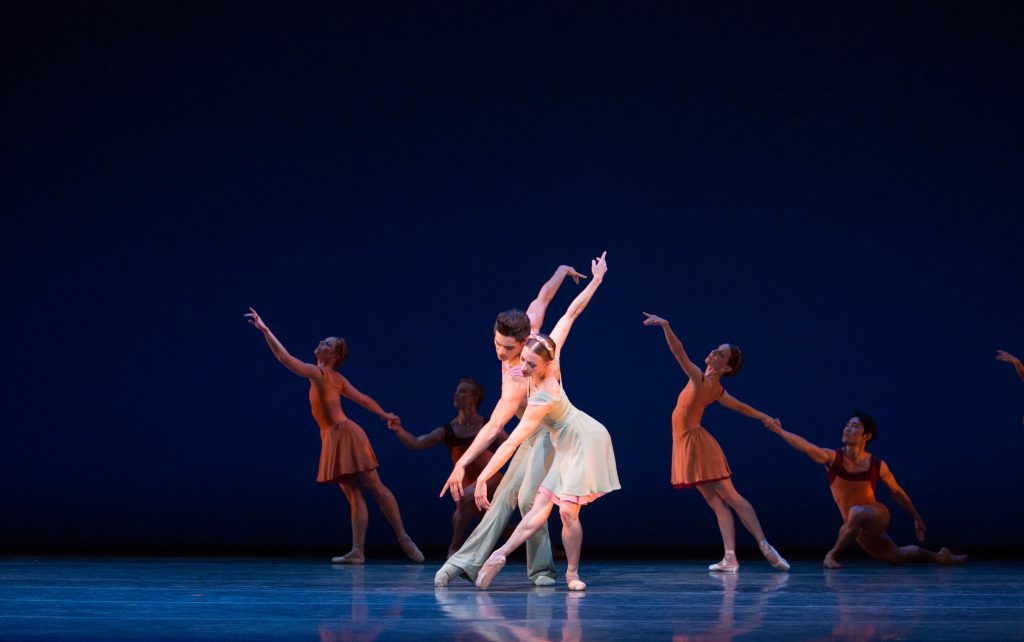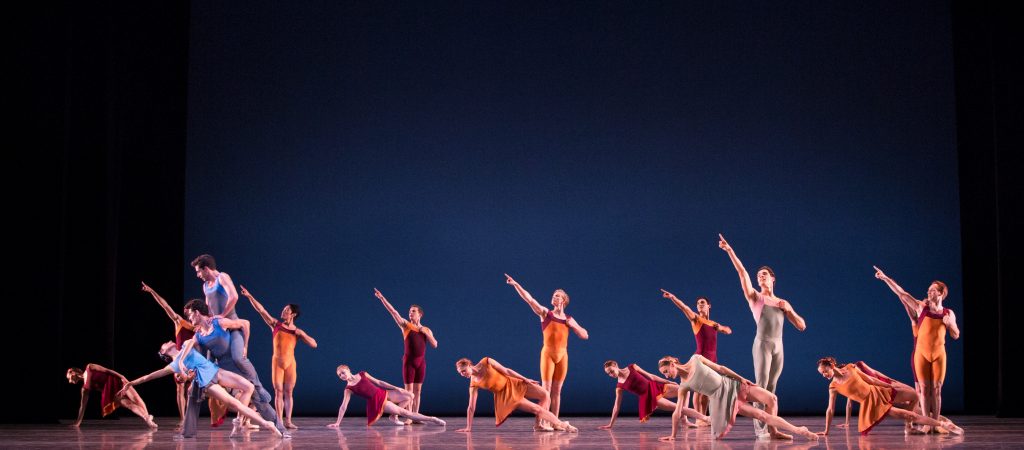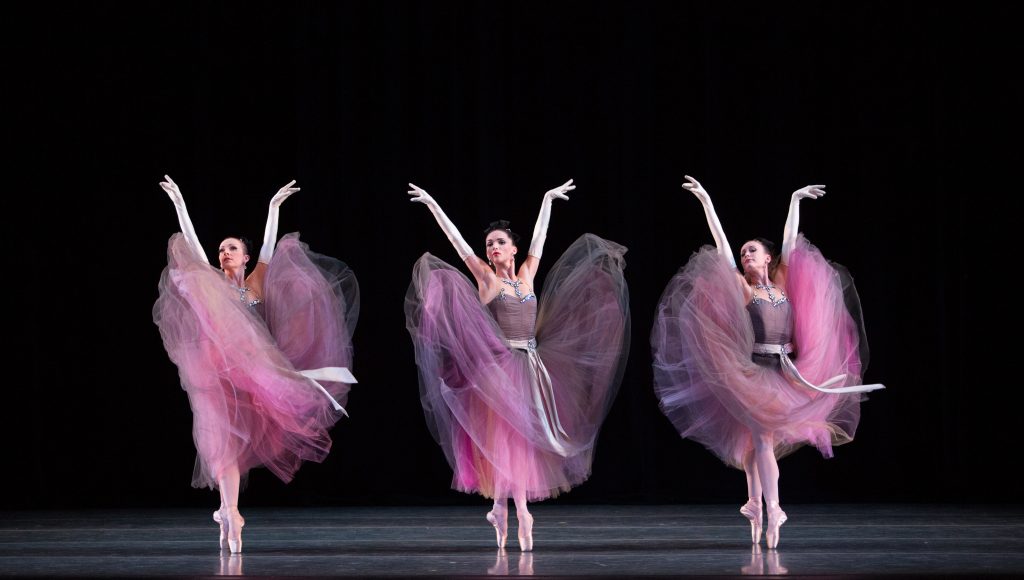
Alexei Ratmansky is undoubtedly the leading choreographer in the ballet world today, clearly poised to become the next Balanchine. So what better place was there to see one of his most acclaimed creations than on the quicksilver and ebullient dancers of Miami City Ballet?
The centerpiece of the closing program of Miami City Ballet’s season was the third work that Ratmansky has set on the company. The first was Symphonic Dances and just last season he set the evening-length The Fairy’s Kiss and both were great successes. At this past weekend’s performances at the Kravis, MCB launched its premiere of Concerto DSCH, an acclaimed earlier work by Ratmansky which was originally choreographed for New York City Ballet in 2008.
Performed by various international ballet companies, it is a wonderfully satisfying work. Filled to the brim with a delightful and endless stream of inventive steps that are flawlessly fused together with the classical ballet vocabulary, it was a perfect vehicle for the talents of the dancers of MCB. However, the repertory works selected to frame this marvelous work seemed monotone in comparison.
Using the Piano Concerto No. 2 by his favorite composer, Dmitri Shostakovich, Ratmansky named Concerto DSCH after the musical motif of four notes that Shostakovich used to represent himself. The score reflects the optimistic energy that the composer felt when the repressions of the Stalinist era were finally lifted.
Concerto DSCH is Ratmansky’s Serenade. Similar to the iconic work that George Balanchine created soon after arriving in the United States from his home country of Russia, Ratmansky choreographed Concerto DSCH soon after he left Russia, where he had been the artistic director of the Bolshoi Ballet.
The central couple, dressed in mint green, were the beautifully paired Simone Messmer and Jovani Furlan. In the Saturday night performance, Messmer was just gorgeous. As always, her beautiful line and technique was there on display but in this role, she exuded a genuine warmth and sensitivity – she has never looked lovelier. Furlan was also outstanding in his part. Their performance together was simply beautiful – subtle, elegant and genuine.

Their playful counterparts, dressed in pale blue, were the teasing trio of Nathalie Arja, Kleber Rebello and Renan Cerdeiro. The playful sparring of technical feats between Rebello and Cerdeiro was spectacular. Setting the mood right at the beginning of the work, they dueled continuously, showing off their steps in impeccable unison or feisty cannon as they highlighted their clear and pristine techniques.
They were joined by the winsome Arja who was more than up to meeting their challenges. At one point, she turned around and partnered each of them in rebounding arabesque jumps.
The rest of the ensemble was divided into two groups: Three couples dressed in burnt orange and four couples dressed in warm red. The cool and warm colors of the costumes – which resembled sleek version of country wear – were designed by Holly Hines. The use of distinct colors for different groups of dancers helped define the design in the sophisticated choreography as the different groups of dancers mixed together and separated in the quickly changing patterns. Together with the saturated hues of the lighting designed by Mark Stanley, the kaleidoscope of the color was a visual feast.
But it was the little gems of unusual and even quirky steps juxtaposed against the known ballet steps – all done with incredible quickness and acute musicality – that really engaged me. The mood of the choreography harked back to a past (perhaps even romanticized) era when times were simple and country folk would come together to dance and enjoy each other’s company in the Russian countryside. A wonderful sense of intimacy was created among the performers as they danced.

Apollo, which opened the program, is considered to be the first great ballet of Balanchine, which he created for Serge Diagheliev’s Ballet Russes 90 years ago to a score by Igor Stravinsky. MCB has been performing Apollo since 1987, but this season a restored version of the familiar work was presented, and it included the original birth scene of Apollo as well as the final ascent to Mount Olympus.
Though it was interesting to see Balanchine’s first version with its wooden staircase to heaven (which looked more like a staircase to a hangman’s noose), the added sections were not that interesting and did not particularly enhance the work’s loose story line.
I understand now why this version is not usually performed. The role of Apollo was danced by Renan Cedeiro with Tricia Albertson, Jennifer Lauren and Emily Bromberg as his three muses.
Closing the program was Balanchine’s 1951 neoclassical work, La Valse, set to Maurice Ravel’s waltz apotheosis. A rather macabre ball unfolded with the ladies, dressed in long white evening gloves and swirling rose tulle, swooning in the arms of the men, who were dressed in black-and-white evening wear complete with short white gloves. The dancing was abruptly brought to a close as Death entered (Reyneris Reyes) and claimed the life of the young debutante (Tricia Albertson).

Theatrically, La Valse was over the top, with its flourishes of bygone romantic drama, but the lack of facial expression and believability made for an unfortunate contrast to the vibrancy and generousness of Concerto DSCH. It was a strange choice to end the season, especially as it dissolved the euphoric mood that Concerto DSCH had so successfully created. It was a downer for an otherwise uplifting evening.
Guest conductor Ormsby Wilkins led The Opus One Orchestra in a lively, well-played performance. Wilkins has been conductor for some of the most outstanding ballet companies in the world, starting in his native country with The Australian Ballet, and continuing with England’s Sadler Wells Ballet, National Ballet of Canada and now American Ballet Theatre.